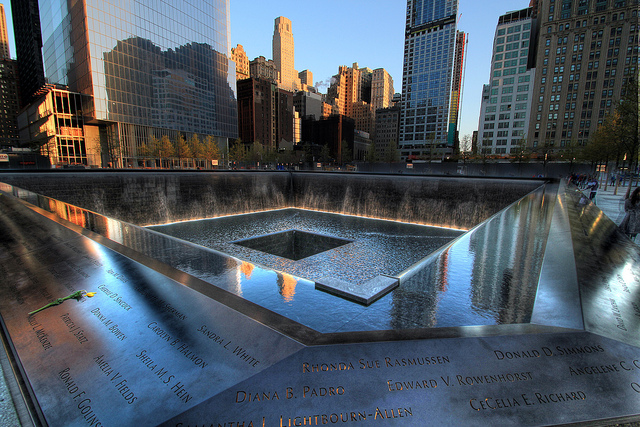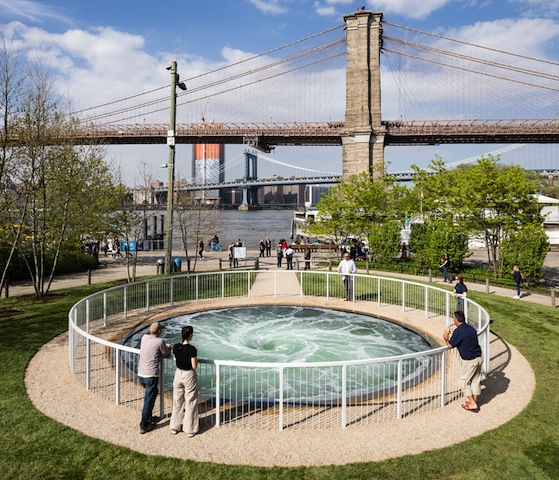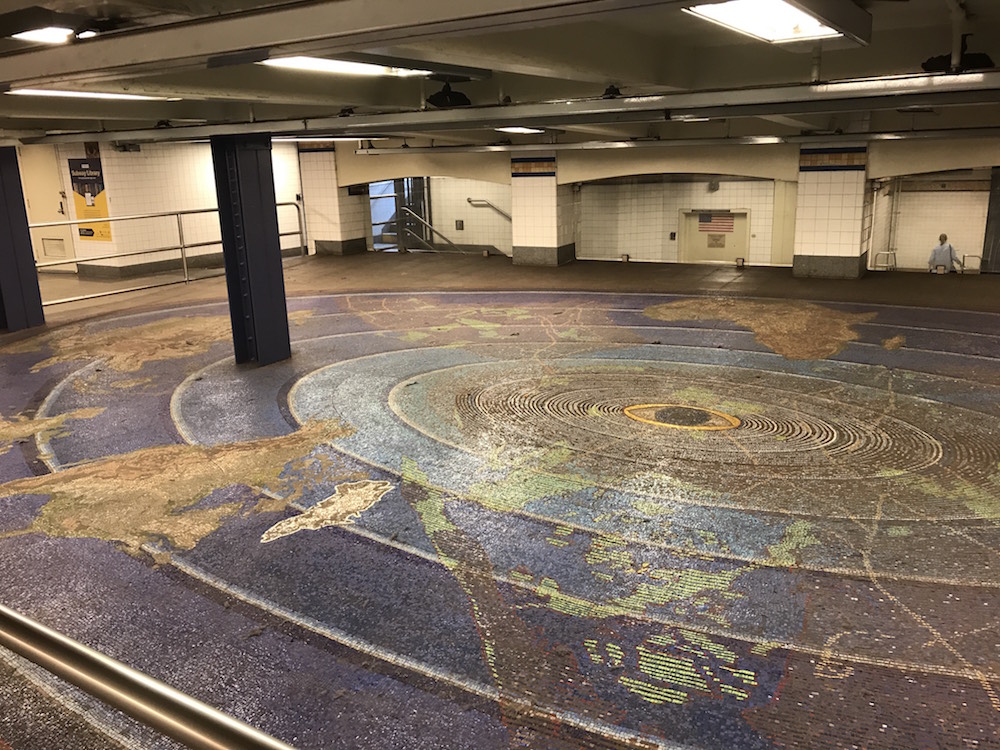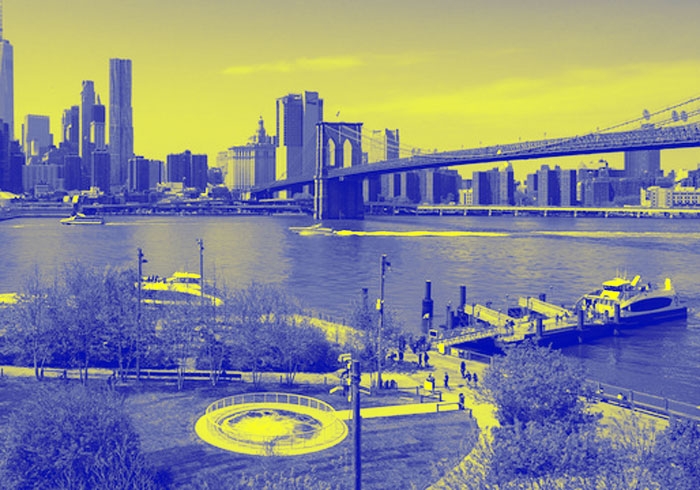I basically walked right through it, that’s how I found it. On my way to a poetry library in Battery Park that promised good wi-fi and aircon and a rare view of the water. You might think that it would’ve been more obvious to me, but like a sun-blind rat, I just walked past this gap, a conspicuous site in one of New York’s densest neighbourhoods. Oh, that’s just Andrew Hamilton’s graveyard, probably. Chess-like games of sidewalk right-of-way cause aloofness in most adults. But there it was – wasn’t – and I acknowledged it with the emotional detachment that would ordinarily mask the embarrassment of something that took place in my youth. Oh yeah, that happened. My soon to be daily routine now included a block-long stretch walking past the National September 11 Memorial, designed by Michael Arad, though I could have just as easily surmised it from the security detail that is palpable for at least a block in every direction, or all the idle cops and those mechanical road blockers that look like they could halt a tank.
When it opened in 2014, a hurricane of negative press pronounced its lack of appropriateness – it’s not America’s memorial, or, much more poignantly, it’s not New York. It doesn’t take a local to notice that the area around Ground Zero has returned to its natural state of out-and-out speculative commerce. On the walk westward toward the memorial, the sudden vacuum between the Freedom Tower’s glassy spire and the empty lot next to it is profoundly difficult to understand: the absence registers as a mistake in personal cognition, a lag with the surrounding physical reality. That it’s just two big holes where the Twin Towers used to be is only few steps away, though only from a distance does the 9/11 Memorial produce this epiphany. Up close, an austere and clunky park surrounds the two square holes, which feature waterfalls. A brass barricade surrounds the cavities, engraved with the victims’ names. This technique will always work, causing a darkness to bubble up from the gut; it will hit me particularly hard where the names of the fire companies are listed alongside their members, who were simply sent to help. There’s no question that it symbolises a grave, a fact occluded by its overall jacuzzi-like appearance.

Cut-rate mid-century Modernism cloaks the things in self-seriousness, though it would be more austere and reverent had it actually been the lobby of one of those buildings
Essentially, visitors lean and look. The scent produced by skin and brass is redolent of my childhood zoo: not particularly nice, charming more for features like brass railings than humane conditions. Imagine some sad looking bears; the prairie dogs who never added cute pups to their ranks. The memorial’s walls are composed of black marble. The water forms a giant square cascade, collects in a basin, and flows into another micro-version of itself in the center. What happens if a kid falls in? Bruteness is worrisome. The whole things stabs at abstraction – majesty, sublimity, tranquillity, reflection, even big numbers – like a tranquilized animal, putting all its weight behind a single thrust that lands it on the ground. Cut-rate mid-century Modernism cloaks the things in self-seriousness, though it would be more austere and reverent had it actually been the lobby of one of those buildings.
Maybe you work downtown and live in Vinegar Hill or Brooklyn Heights. Were you early to buy in DUMBO? Maybe your company volleyball team plays on Pier 6. Maybe you took the water taxi from the Financial District to Brooklyn Bridge Park on a recommendation, or a whim. Maybe you walked across the bridge, finally. Maybe your fanaticism for Hart Crane’s poem The Bridge (1930) inspired a visit, only to remember all the men permanently interred in the bridge’s pilings. Its construction led to the discovery of the bends, then known as caisson disease, in 1873. Who are we kidding? The best antidote to being stuck in the city’s streets, or scuttling too-long in the subway, is a view of Manhattan, and the best place to get that is from Brooklyn’s vantage point. Save for one critic’s weekly unlimited metro pass, though, little connects the 9/11 Memorial and Brooklyn Bridge Park outside of their shared stature as landmarks – that’s about it. It’s just not a commute anyone would make. But that’s the mental leap we’re taking, to visit Anish Kapoor’s Descension, recommissioned by Public Art Fund, and installed for the summer near the ferry dock.

Descension is a whirlpool some eight metres across. It’s located on the Old Fulton Street entrance, at the end of a meadow and surrounded by a purpose-built fence. There, it burps and bubbles and occasionally discharges. A byproduct of its consuming rush is that it takes in a lot of air, making it almost ceremoniously flatulent – it’s decadent, suited to the hypertrophied estate of the contemporary uber-rich (a previous iteration was part of the artist’s solo exhibition at Versailles in 2015). Gulp. Yes, that’s my puddle of indigestion. Its centre doesn’t remain stationary, and instead spirals according to some exceptional law of fluid dynamics. To put it lightly, Kapoor’s work is always over the top. It’s the type of thing that thrives on the big reveal, there’s no reason to see it twice. Descension is small-scale in comparison to Kapoor’s other work, but its might lies in the mechanics that make it churn. It makes the ground rumble, but kids still throw pennies into it.
Together, the 9/11 Memorial and Kapoor’s Descension are undeniably oral. Or anal. A pair of morbid buttholes. Wet, gaping mouths
Together, the 9/11 Memorial and Kapoor’s Descension are undeniably oral. Or anal. A pair of morbid buttholes. Wet, gaping mouths. And like both of these orifices, there are byproducts to their use. Both works are elemental: big, singular gestures, scaled up for appeal. Both evoke mythology, generally so. Both are about materials and their simple capacity to awe. Both have something to do with negative space, either an underworld or an afterlife. Both could also be seen as drains. Jet skis whizz nearby, and the water taxi horns issue at regular intervals. I’ve always revered the Brooklyn Bridge, the inauguration of which was said to be more captivating to New Yorkers than the moon landing. It’s hard to have the same relationship to the area surrounding the former World Trade Center buildings, since New York’s founding, rapid change has contorted this part of the island for centuries. What of its character is left? The first-ever car bombing took place in front of the former J.P. Morgan Bank on Wall Street in 1920.
What does it take for someone to change the narrative of the site? Boldness? Neither of these works has it. One is at least recreational. Both are farty. A side-eyed snicker comes across my face thinking about them burping and farting away, late into the night, all the city’s energy they consume, and all the junkspace they’re excreting.
—
New Yorkers make a sport of complaint, especially about the MTA. A frequent headline in the New York Times for the past several months has been ‘Why Is Subway Service in New York Getting Worse?’ The MTA is a monolith, one of the last public authorities to continue to wield such widespread influence, though over the decades it has been the stepchild to both the city and state. It has taken a literal lifetime to extend the 2nd Avenue subway line three stops; fares went up again, you know. It always drips and floods when it rains. That the rattling force of a subway train can be felt through the sidewalk is one reason why a subterranean metaphor – of damp holes in the ground – is the province of widespread complaint. New Yorkers are rat people, they live in tiny boxes and scuttle through festering tunnels every day.
Sixteen years after the terrorist attacks on 9/11 and still the World Trade Center Station (PATH), which connects interstate train travel, and which was destroyed in the event, has yet to re-open. July and August 2017 has been dubbed ‘the summer of hell’, because of construction at Penn Station, which has borne the added strain over the last decade and a half. It’s been a favourite of the Daily News and the New York Post. The L train has been under threat of closure. I take the B or the Q train to Atlantic/Barclays Station, transfer to the 2 or the 3 train, and ride until Chambers Street, though this summer that commute frequently includes interruptions. It can be up to thirty minutes, but that’s rare; usually long enough to engender that dreadful guilt that my day’s gone wrong.

After re-visiting the 9/11 memorial, I entered the Chambers station through a different stairwell than usual and discovered Oculus (1998) by Kristin Jones and Andrew Ginzel in the station. Almost a relic, it was dusty, fenced off by a railing, and already cramped in a low clearance area. The mosaic’s composition was still clearly visible: a huge eye radiating from the central pole of a world map. What I like about the subway art in New York is that they let it get dirty.
